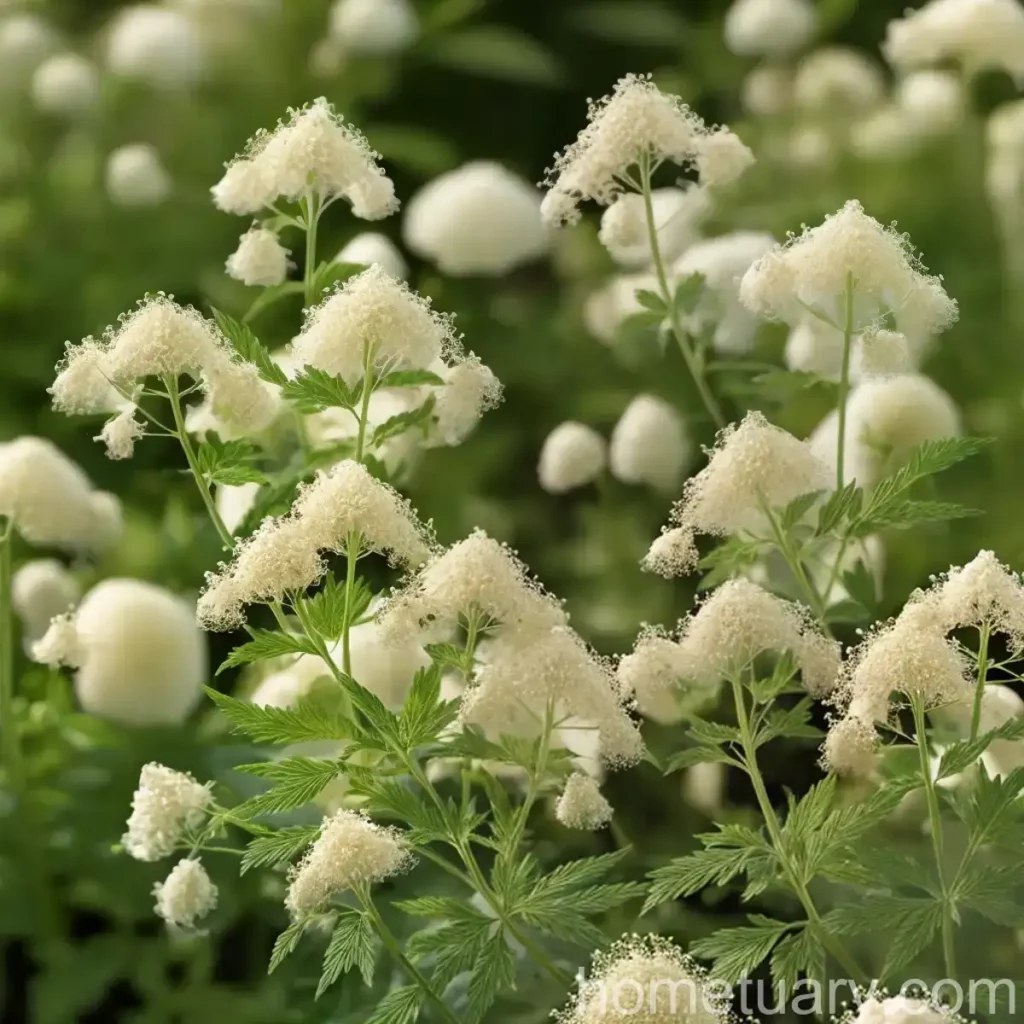Meadowsweet (Filipendula denudata): A Plant Scientist’s Guide
Meadowsweet (Filipendula denudata) is a beautiful and versatile plant that has been utilized for various cultural, medicinal, and horticultural purposes over the years. As a plant scientist, I am excited to share my knowledge and insights regarding this fascinating plant. In this comprehensive guide, we will delve into the description, cultivation, uses, and other aspects of meadowsweet, offering valuable information for both plant enthusiasts and those interested in the diverse applications of this plant.
What is Meadowsweet (Filipendula denudata)?
Meadowsweet, scientifically known as Filipendula denudata, is a perennial herbaceous plant belonging to the Rosaceae family. It is native to East Asia, including regions such as China, Japan, and Korea. This plant is celebrated for its striking appearance, featuring delicate, fluffy clusters of creamy white flowers that emerge in abundance during the summer months. The foliage of meadowsweet is characterized by serrated, deeply lobed leaves, adding to its ornamental appeal.
Key Takeaways – Meadowsweet (Filipendula denudata)
Before delving into specific aspects of meadowsweet, let’s highlight some key takeaways that encompass its various facets and applications:
- Meadowsweet is a perennial herbaceous plant known for its exquisite creamy white flowers and serrated leaves.
- The plant has diverse cultural, medicinal, and horticultural uses, contributing to its significance in different contexts.
- Understanding the ideal conditions and care guidelines for cultivating meadowsweet is essential for promoting its healthy growth and blooming.
Cultural Uses of Meadowsweet
Meadowsweet has been revered for centuries in various cultures for its aesthetic appeal and symbolic significance. Its use in decorative arrangements, traditional rituals, and folklore demonstrates the enduring cultural relevance of this enchanting plant.
Symbolism and Folklore
Throughout history, meadowsweet has been associated with different symbolic meanings and folklore. In some traditions, the plant symbolizes love, beauty, and adornment, making it a popular choice for wedding bouquets and floral decorations. Additionally, meadowsweet is often linked to themes of purity, innocence, and tranquility, reflecting its serene and delicate appearance.
Traditional Healing Practices
In certain cultures, meadowsweet has been utilized as a symbol of healing and well-being. The plant holds significance in traditional medicine systems, with its flowers and leaves being employed to create herbal remedies aimed at alleviating various ailments. Its presence in traditional healing practices underscores its perceived therapeutic properties and botanical significance.
Uses of Meadowsweet in Herbal Medicine
The rich history of meadowsweet encompasses its utilization in herbal medicine, where it is valued for its potential health benefits and medicinal properties. From pain relief to digestive health, meadowsweet has been traditionally employed to address a range of health concerns.
Medicinal Properties
Meadowsweet is renowned for its anti-inflammatory and analgesic properties, with its flowers and leaves containing compounds that are believed to contribute to these therapeutic effects. Furthermore, the plant has been associated with digestive benefits and is often used to support gastrointestinal wellness. Its potential as a natural remedy for various conditions has piqued the interest of herbalists and wellness enthusiasts seeking alternative and holistic approaches to health.
Remedial Applications
In herbal medicine, meadowsweet is used in various forms, including teas, tinctures, and extracts. These preparations are crafted to harness the plant’s beneficial compounds and are often recommended for addressing discomfort and promoting overall wellness. Meadowsweet’s historical and contemporary use in herbal medicine underscores its enduring relevance in the realm of natural healing and wellness practices.
Cultivation and Care of Meadowsweet
Ideal Conditions for Filipendula denudata
Creating the optimal environment for meadowsweet is crucial for its overall health and vigor. By understanding its preferred growing conditions, enthusiasts can cultivate thriving meadowsweet plants with abundant blooms and robust foliage.
Water
Meadowsweet thrives in moist, well-draining soil and benefits from consistent moisture, especially during the growing season. Adequate irrigation is essential for encouraging healthy growth and blooming, making it important to monitor the plant’s water requirements and ensure that it does not experience prolonged periods of drought.
Sunlight
When it comes to sunlight, meadowsweet thrives in partial shade to full sun conditions. While it can tolerate some shade, providing ample sunlight can enhance blooming and overall plant vitality. Therefore, positioning meadowsweet in a location that receives adequate sunlight or dappled shade is recommended for optimal growth.
Soil
The ideal soil for meadowsweet is rich, loamy, and slightly acidic. It is important to ensure good drainage to prevent waterlogging, as meadowsweet prefers soil that is consistently moist but not waterlogged. Amending the soil with organic matter can further enhance its suitability for meadowsweet cultivation.
Fertilizer
In terms of fertilization, meadowsweet benefits from a balanced, slow-release fertilizer applied in early spring. A general-purpose fertilizer with balanced NPK ratios can support the plant’s nutritional needs and contribute to its overall health and vigor. It is advisable to follow the manufacturer’s recommendations regarding application rates and frequency.
Pruning
Pruning plays a pivotal role in maintaining the form and vitality of meadowsweet. Regular deadheading of spent flowers can promote continuous blooming, while periodic pruning of the foliage can help manage the plant’s shape and size. It is important to use clean, sharp pruning tools to prevent damage to the plant and ensure proper wound healing.
Propagation of Meadowsweet
Meadowsweet can be propagated through various methods, offering enthusiasts the opportunity to multiply their plant collection and share the beauty of this captivating species.
Division
Division is a common propagation method for meadowsweet, typically carried out in early spring or fall. By carefully dividing the plant’s rhizomes and root sections, new individuals can be established, each with the potential to develop into robust, blooming plants. Proper division techniques and attention to root health are essential for successful propagation through this method.
Seed Propagation
Growing meadowsweet from seed presents another avenue for propagation, allowing enthusiasts to start new plants from scratch. Sowing seeds in a well-prepared seedbed or containers and providing appropriate care can lead to the emergence of seedlings that can later be transplanted into desired growing locations.
Container Cultivation of Meadowsweet
Although meadowsweet is often grown in garden beds and borders, it can also thrive in containers, offering versatility in horticultural settings and urban gardening environments.
Container Selection
When choosing containers for meadowsweet, opt for spacious pots with adequate drainage holes to facilitate proper moisture management. Containers with a volume suitable for accommodating the plant’s root system and promoting healthy growth are ideal for cultivating meadowsweet effectively.
Potting Mix
Selecting a well-draining, nutrient-rich potting mix is essential for container cultivation of meadowsweet. A mix formulated for perennial plants and enriched with organic matter can provide an optimal growing medium that supports the plant’s development and blooming.
Maintenance Considerations
Regular watering, fertilization, and monitoring of sunlight exposure are essential for maintaining meadowsweet in containers. Additionally, periodic repotting may be necessary as the plant grows, allowing for continued expansion and healthy root development.
Popularity of Meadowsweet
Meadowsweet’s enduring popularity stems from its captivating appearance, versatile applications, and horticultural appeal. Whether in traditional gardens, herbal medicine practices, or cultural contexts, the plant continues to captivate enthusiasts and practitioners alike.
Horticultural Significance
In horticulture, meadowsweet is valued for its ornamental qualities, with its graceful, airy blooms and lush foliage adding charm to garden settings. Its perennial nature and adaptability further contribute to its appeal as a garden plant, making it a sought-after choice for those seeking an elegant and low-maintenance addition to their landscapes.
Herbal and Medicinal Relevance
The plant’s significance in herbal medicine and natural remedies has sustained its popularity among wellness enthusiasts and practitioners of holistic healing. Meadowsweet’s association with wellness and its traditionally recognized benefits have contributed to its continued utilization in herbal preparations and natural health products.
Common Diseases of Meadowsweet
Disease Diagnosis
Meadowsweet, like many plants, is susceptible to certain diseases that can affect its growth and overall vigor. Understanding common diseases and their symptoms is essential for implementing effective disease management strategies and preserving the health of meadowsweet plants.
Powdery Mildew
Powdery mildew, characterized by a powdery white coating on the plant’s foliage, can impact meadowsweet, particularly in conditions of high humidity and poor air circulation. Monitoring the plant for signs of powdery mildew and implementing cultural and, if necessary, chemical controls can help mitigate the impact of this common fungal disease.
Rust
Rust, manifested as rusty-orange to brown spots on the leaves, is another potential issue that may affect meadowsweet. Regular inspection of the plant’s foliage and timely intervention through proper sanitation and management practices can help prevent the spread of rust and minimize its impact on meadowsweet.
Common Pests Affecting Meadowsweet
Pest Identification
In addition to diseases, meadowsweet may also face challenges from various pests that can compromise its health and vitality. Recognizing common pests and their impact is essential for implementing targeted pest management measures and safeguarding the plant from potential damage.
Aphids
Aphids, small sap-sucking insects, can infest meadowsweet, leading to distorted growth and weakened plant vigor. Monitoring for aphid populations and employing physical or biological control methods can help manage aphid infestations and protect meadowsweet from their detrimental effects.
Sawflies
Sawflies, known for their larvae that feed on plant foliage, can pose a threat to meadowsweet. Regular inspection of the plant for signs of sawfly damage and the implementation of appropriate control measures are vital for mitigating the impact of these pests and preserving the plant’s health.
Botanist’s Tips for Growing Meadowsweet
Proper Site Selection
Selecting an appropriate growing site with the right light conditions and soil quality is essential for the successful cultivation of meadowsweet. By choosing a location that meets the plant’s preferences, enthusiasts can facilitate its optimal growth and blooming.
Attention to Watering
Maintaining adequate moisture levels, especially during periods of active growth and flowering, is crucial for promoting healthy meadowsweet plants. Regular monitoring of the plant’s water needs and thoughtful irrigation can contribute to its overall vitality and resilience.
Disease and Pest Management
Vigilance regarding potential diseases and pests, along with timely intervention and preventive measures, can help ensure that meadowsweet remains free from harmful infestations and the associated damage.
Integrated Care Approaches
Employing integrated plant care approaches, which encompass various cultural, biological, and, if necessary, chemical control methods, can support the overall well-being of meadowsweet plants. Balancing different care strategies can contribute to a holistic and effective approach to meadowsweet cultivation.
Fun Facts about Meadowsweet
Rich History
Meadowsweet has a rich history deeply rooted in various cultural, medicinal, and horticultural contexts, reflecting its enduring significance and appeal across different domains.
Aromatic Qualities
The plant is known for its fragrant flowers, which emit a sweet, almond-like scent. This aromatic feature adds to its allure and makes it a delightful addition to gardens and natural settings.
Wildlife Attraction
Meadowsweet’s floral abundance and nectar-producing flowers make it an attractive option for pollinators such as bees and butterflies, contributing to its role in supporting local ecosystems and biodiversity.
Links to External Resources
For those seeking further information and resources related to meadowsweet, the following links provide valuable insights and details:
- Royal Horticultural Society – Meadowsweet (Filipendula) Plant Profile
- The Plant List – Filipendula denudata
- Missouri Botanical Garden – Filipendula denudata
- PubMed Central – The Botany, Phytochemistry, Pharmacology, Traditional Uses and Health Benefits of Meadowsweet
Meadowsweet, with its captivating beauty, diverse applications, and historical significance, continues to be a plant of interest and admiration. Whether in gardens, herbal remedies, or cultural traditions, its presence adds charm and value, reflecting the enduring appeal of this enchanting herbaceous perennial. Understanding the key aspects of meadowsweet, from its cultivation and uses to its ecological role and cultural significance, offers a deeper appreciation for this multifaceted plant that has woven itself into various aspects of human life and natural environments.















